To develop full, proportional shoulders, you have to make rear delt exercises a priority.
Why?
Because most people spend plenty of time training their front and side delts with presses and side raises, but much less time building the back of their shoulders with rows, reverse flys, and the like.
Over time, this causes a “front-heavy” look that throws your upper body aesthetics out of whack.
What’s more, it can also increase your risk of shoulder injury and hinder your athletic performance.
In this article, you’ll learn to avoid this common pitfall. You’ll discover exactly what the rear delts are, the benefits of training them, tips to make your rear delt training as effective as possible, the best rear delt exercises for mass and strength, and more.
What Are the Rear Delts?
The deltoids—or “delts”—are the muscles that cover your shoulder joints and help move your upper arms forward, upward, and backward.
Each deltoid comprises three sections or “heads:” the anterior deltoid, the lateral deltoid, and the posterior deltoid.
Here’s how they look on your body:
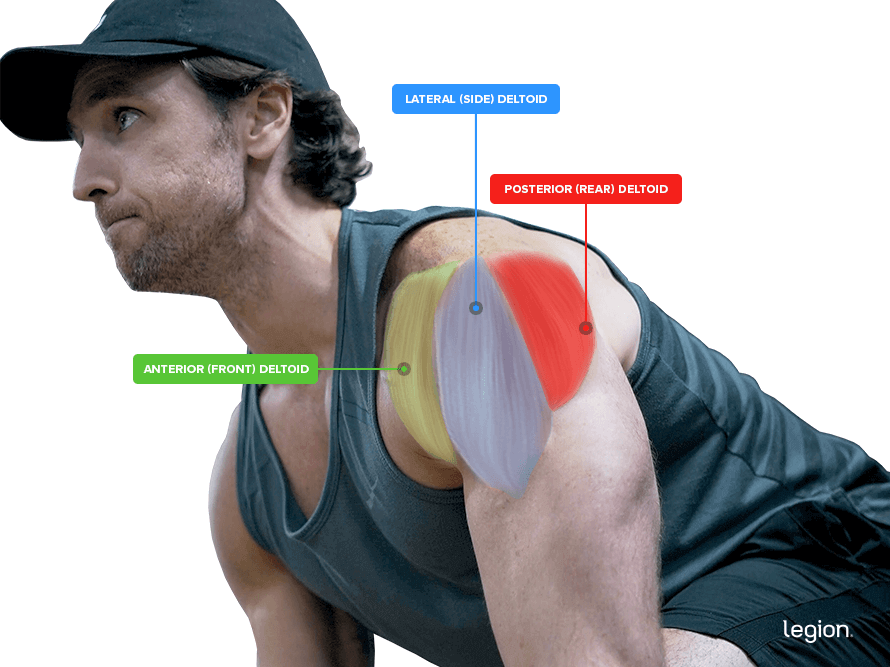
The posterior deltoids are better known among weightlifters as the “rear delts” because they’re located behind your shoulder joints on your upper back.
The Benefits of Training Your Rear Delts
Training your rear delts offers two important benefits:
- It ensures that your shoulders are proportional: The rear delts are smaller and more stubborn than the other heads of the deltoids, which means they often need a bit of extra attention in the form of good rear delt exercises if you want them to grow at the same rate as your front and side delts.
- It improves the health of your shoulders: Many weightlifters spend more time training their front and side delts with pushing exercises like the bench press, overhead press, and lateral raise, than they do training their rear delts with pulling exercises like the barbell row, pull-up, and lat pulldown.
Over time this can cause a strength and size imbalance between your rear delts and your front and side delts, which may increase your risk of injury.
The 12 Best Rear Delt Exercises for Mass
Below are the 12 best rear delt exercises for mass. Make these the focus of your rear delt workouts and you’ll see size gains in no time.
1. Barbell Row
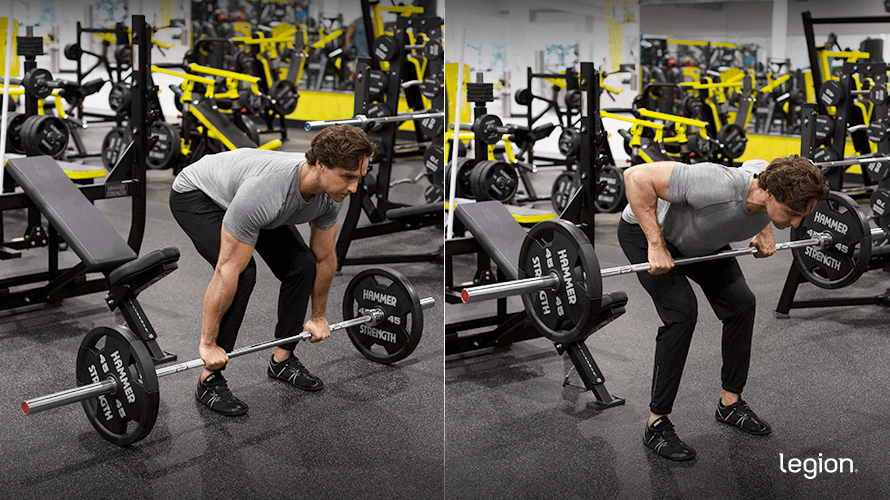
The barbell bent over row allows you to lift heavy weights safely, which makes it ideal for training your entire back and gaining upper-body strength.
How to:
- Position your feet shoulder-width apart under a loaded barbell with your toes pointed slightly outward.
- Bend over and grab the bar with a slightly wider than shoulder-width grip and with your palms facing toward you.
- Straighten your back and raise your hips until your back is roughly parallel to the floor.
- Driving through your legs, then, using the momentum generated by your lower body, pull the barbell to your upper body, touching it anywhere between your lower chest and belly button.
- Reverse the movement and return it to the starting position.
2. One-Arm Dumbbell Row
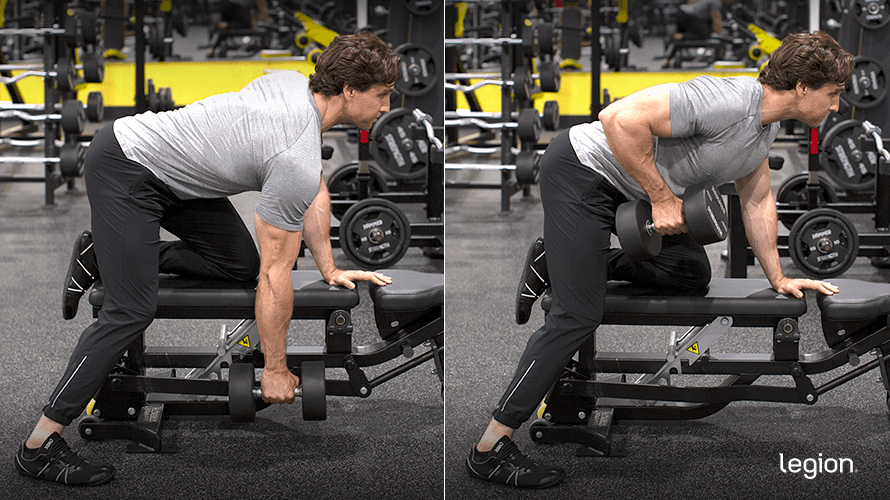
The one-arm dumbbell row is one of the best rear delt exercises with dumbbells because it trains each side of your body independently, helping you find and fix muscle imbalances.
How to:
- Hold a dumbbell in your right hand.
- Plant your left knee and hand firmly on a bench, your right foot on the floor a foot or two from the bench, and let your right arm hang toward the floor.
- Keeping your back straight, pull the dumbbell upward until it touches your torso, and then return the dumbbell to the starting position.
- Once you’ve completed the desired number of reps, repeat the process with your left arm.
3. Pull-up

The pull-up is a fantastic bodyweight rear delt exercise that’s ideal if you have very little equipment available.
How to:
- Grab a pull-up bar slightly wider than shoulder-width apart with your palms facing away from you.
- Lift your feet so that you’re hanging with your arms straight.
- Pull your body up until your chin is above the bar.
- Reverse the movement and return to the starting position.
4. Chin-up
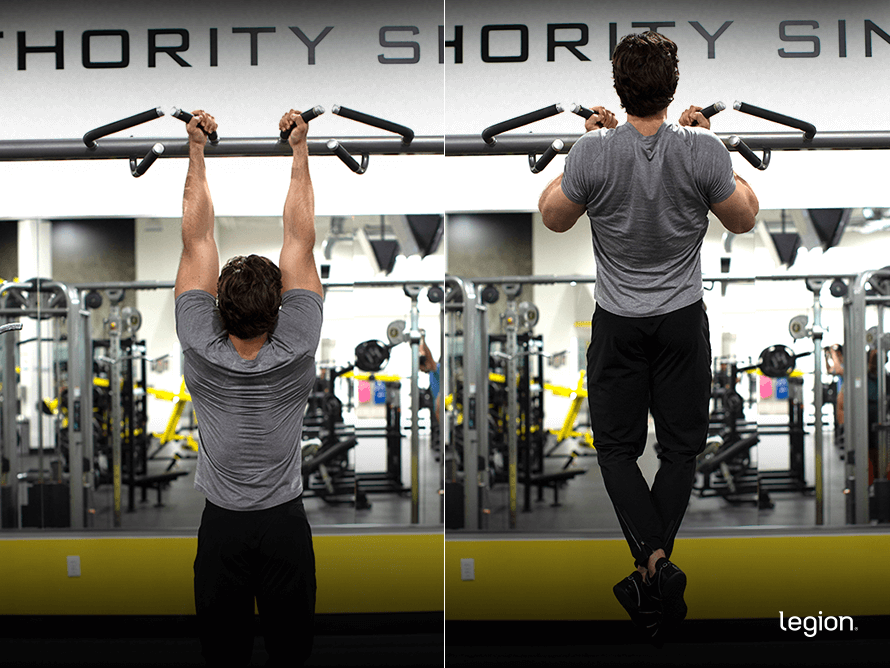
Like the pull-up, the chin-up is one of the best bodyweight rear delt exercises you can do. What makes them slightly different, though, is that the chin-up allows you to train the muscle through a larger range of motion, which is generally superior for muscle growth and strength gains.
How to:
- Grab a pull-up bar with your hands around shoulder-width apart and your palms facing toward you.
- Lift your feet so that you’re hanging with your arms straight.
- Pull your body up until your chin is above the bar.
- Reverse the movement and return to the starting position.
5. Lat Pulldown
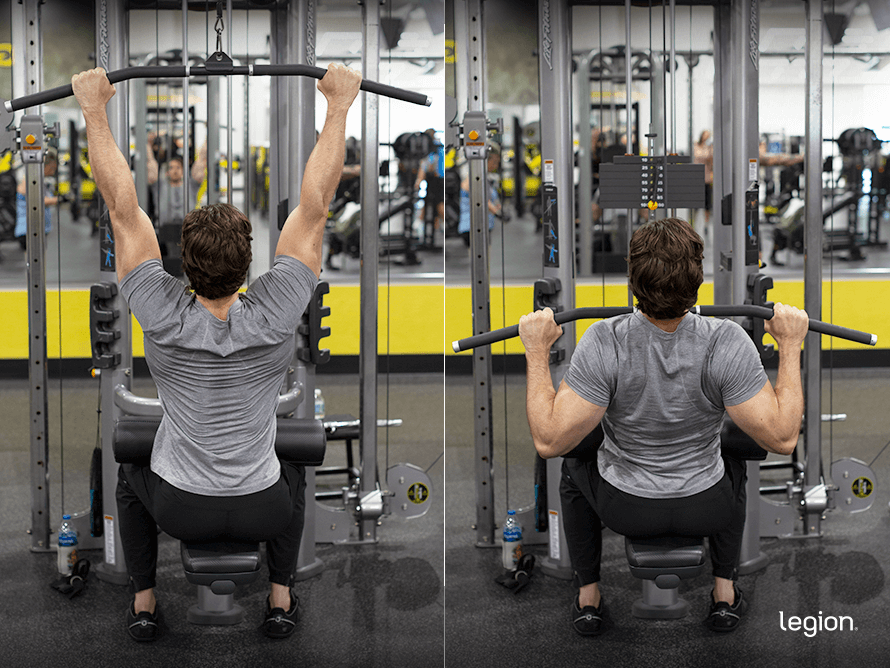
The lat pulldown is an excellent exercise for training your back and rear delts, especially if you’re a beginner and don’t have the upper-body strength to do pull-ups.
How to:
- Adjust the thigh pad so that it locks your lower body in place.
- Stand up and grab the bar. While keeping your grip on the bar and your arms straight, sit down, allowing your body weight to pull the bar down with you. Nudge your thighs under the pads and plant your feet on the floor.
- Pull the bar toward your chest.
- Once the bar is underneath your chin (or touches your chest, if you want to make the exercise harder), reverse the movement and return to the starting position.
6. Seated Cable Row
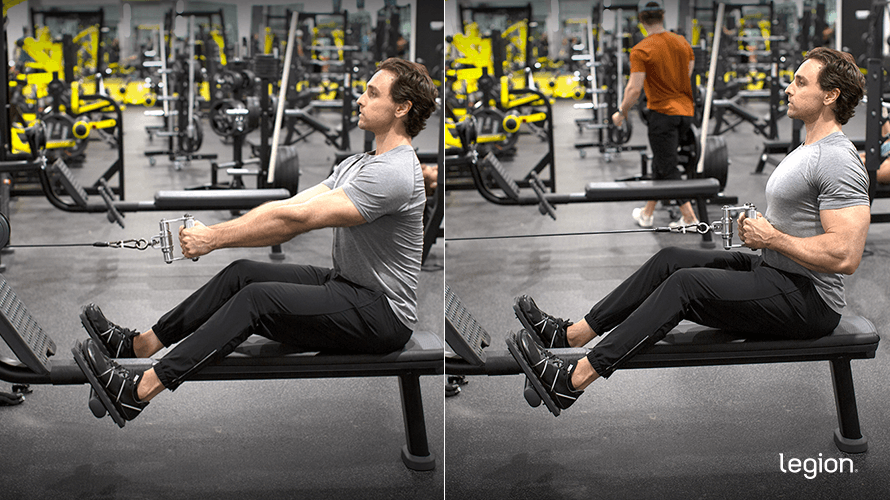
One benefit of doing cable rear delt exercises like the seated cable row is that the cable offers constant tension throughout the set, which stimulates your rear delts slightly differently to other free-weight back exercises.
How to:
- Sit down and place your feet on the foot-rest while maintaining slightly bent knees.
- Lean forward and grab the handle, then lean back with your arms stretched in front of you.
- Straighten your back and pull the cable toward your stomach.
- Once your hands touch your torso, reverse the movement and return to the starting position.
7. Barbell Rear Delt Row
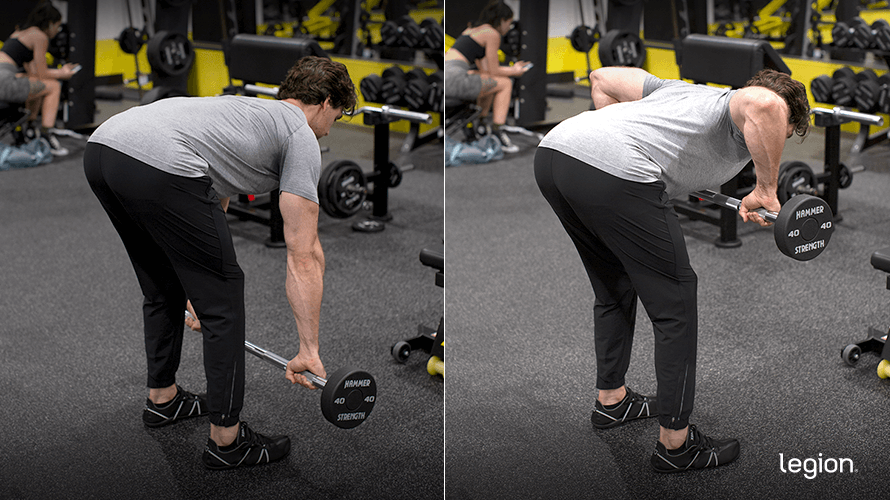
The barbell rear delt row is similar to the barbell row except that you pull the weight to your mid chest instead of your stomach. This reduces the amount your lats contribute to the exercise, and makes it more taxing on your upper back and rear delts.
How to:
- Position your feet under a loaded barbell about shoulder-width apart with your toes pointed slightly outward.
- Bend over and grab the bar with a slightly wider than shoulder-width grip and with your palms facing toward you.
- Flatten your back so that it’s roughly parallel to the floor and let your arms hang straight down.
- Pull the barbell to your mid chest, making sure to flair your elbows at about a 60-degree angle relative to your body.
- Once the bar touches your body, reverse the movement and return to the starting position.
8. Dumbbell Rear Lateral Raise
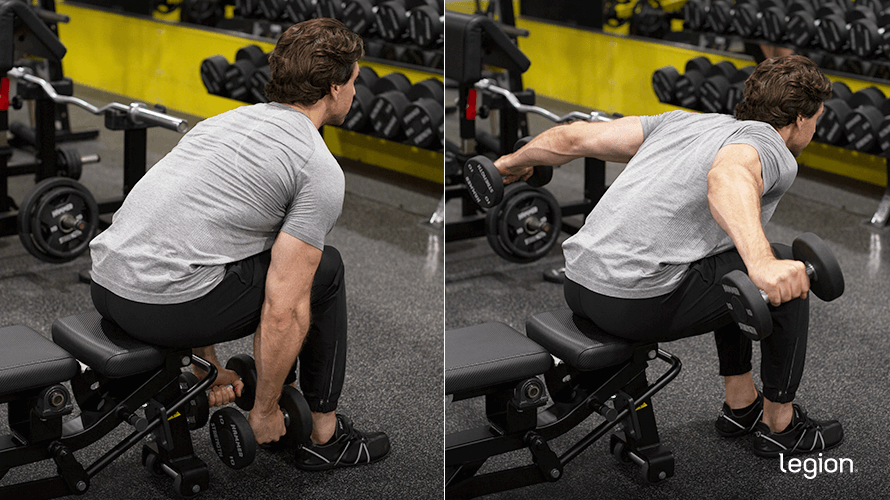
As well as being one of the best dumbbell rear delt exercises, the dumbbell rear lateral raise effectively trains the traps and rhomboids.
How to:
- Whether standing or seated, bend at the hips so that your upper body is as close to parallel to the floor as possible.
- Hold a dumbbell in each hand, and while keeping your back flat, lift the dumbbells out to the side until your upper arm is parallel to the floor.
- You don’t have to keep your arms perfectly straight—having a small bend in your elbows is normally more comfortable.
- Reverse the movement and return to the starting position.
9. Machine Reverse Fly

Research shows the machine reverse fly activates the rear delts more than exercises like the seated cable row and lat pulldown. This doesn’t necessarily mean it’s more effective than these exercises for developing your rear delts (especially since you can use far less weight with the machine reverse fly), but it’s a viable alternative.
How to:
- Sit down with your body facing the machine and your feet firmly on the floor. The handles should be at the same height as your shoulders.
- Grab the handles with your palms facing down and press your chest against the pad. While maintaining a slight bend in your elbows, move the weight back in an arc until your arms are directly out to your sides (or slightly behind your body).
- Reverse the movement and return to the starting position.
10. Face Pull
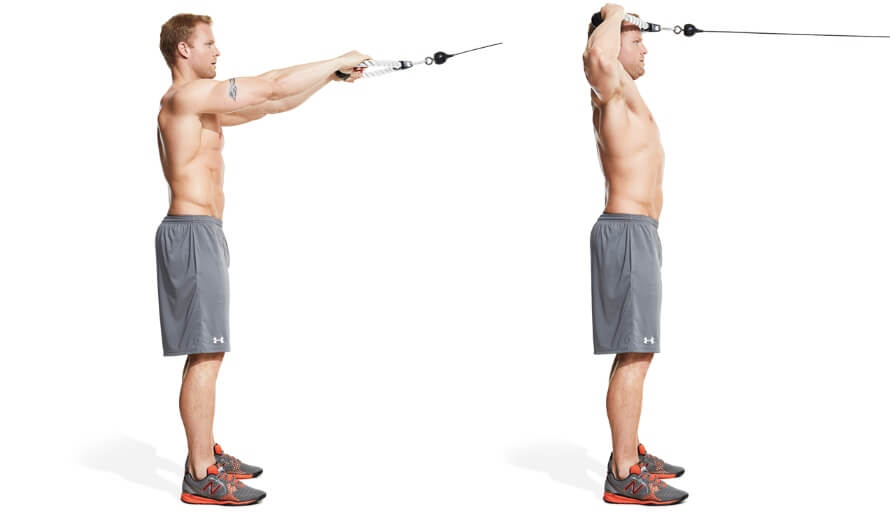
The face pull trains all the muscles responsible for pulling horizontally toward your face (including the rear delts) and strengthens the shoulder muscles that rotate your arm upward. These benefits are unique to the face pull and may improve shoulder health.
How to:
- Set the pulley on a cable machine to eye level and attach the rope handle.
- Grip one end of the rope in each hand then take a few steps away from the pulley so that there’s tension in the cable and your arms are stretched in front of you.
- Stand up straight with a slight bend in your knees and place your feet shoulder-width apart. While keeping your elbows up, pull the rope toward your eyes, allowing your hands to pull the rope apart until your hands are above your shoulders.
- Reverse the movement and return to the starting position.
11. Cable Upright Row

The cable upright row trains your rear delts to a high degree. Using a cable also keeps constant tension on your muscles, which may benefit growth.
How to:
- Set a cable machine pulley to the lowest setting and attach the straight-bar attachment.
- Stand in front of the pulley and hold the bar in front of your thighs with your palms facing you.
- Lift the bar straight upward until your upper arms are parallel with the floor, keeping your elbows higher than your forearms throughout the movement.
- Reverse the movement and return to the starting position.
12. Resistance Band Pull Apart
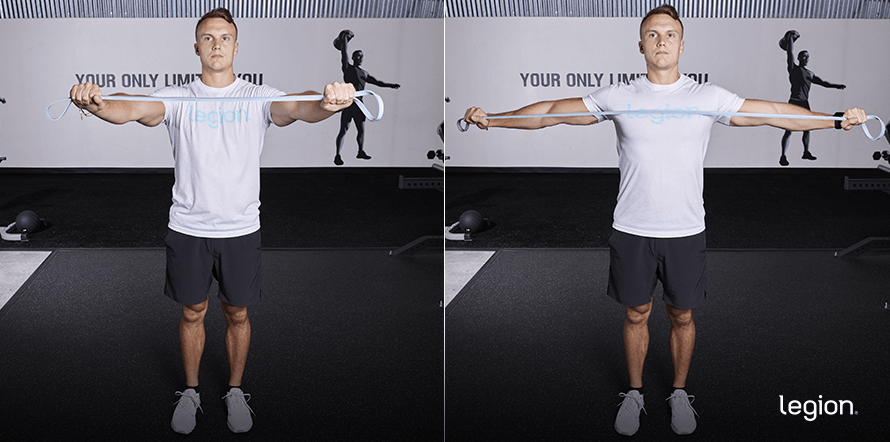
The band pull apart requires little equipment, so it’s a convenient rear delt exercise for times when you don’t have access to free weights or machines (while traveling, for example).
How to:
- While standing upright, hold a light resistance band at arms’ length in front of your chest with a shoulder-width grip and your palms facing the floor.
- Adjust your grip so there’s tension in the band when your hands are shoulder-width apart.
- Move your hands away from each other until your arms are directly out to your sides and the band touches your chest.
- Reverse the movement and return to the starting position.
Rear Delt Training Tips
Here are four tips to ensure you get maximum results from your rear delt workouts.
1. Do the right rear delt-focused exercises.
The “secret” to building well-developed rear delts is to get as strong as possible on compound exercises that train your rear delts. And that means dedicating most of your training time to pull-up, pulldown, and row variations.
That said, if you want to maximize rear delt growth, research shows that it’s worth doing isolation exercises that emphasize your rear delts, too (more on the best compound and isolation rear deltoid exercises soon).
A solid approach is to spend 80% of your training time on compound movements that train your rear delts, and the remaining 20% on rear delt isolation exercises.
2. Use the right mix of volume and intensity.
You can do all the best rear delt exercises for mass, but they won’t have the desired effects if you don’t also manage volume and intensity correctly. Here’s what you need to know:
- Train your rear delts with 10-to-20 weekly sets: If you’ve been training for less than a year, doing 10-to-15 weekly sets is sufficient. If you’ve trained longer than a year, doing 15-to-20 weekly sets split over 2-to-3 workouts will yield better results.
- Use 85-to-90% of your one-rep max for most sets: Do ~75% of your rear delt exercises in the 4-to-6 rep range (85-to-90% of your one-rep max) and the remaining ~25% with slightly lighter weights (7-to-12 rep range).
- End all sets 1-to-3 reps shy of failure: To maximize your results, take most sets of rear deltoid exercises close to failure. Ask yourself at the end of each set, “If I had to, how many more reps could I have gotten with good form?” If the answer is more than two, increase the weight or reps to make your next set more challenging.
3. Once you hit the top of your rep range for a set, move up in weight.
If you stop getting stronger, your rear delts will eventually stop getting bigger (this applies to every major muscle group in the body).
The simplest way to get strong and build muscle is to use double progression. For example, if your rear delt workout calls for 4-to-6 reps of the barbell row and you get 6 reps for a set, add 10 pounds to your next set.
If you manage 3 or fewer reps with the new weight, reduce the weight by 5 pounds to ensure you stay in the 4-to-6 rep range.
Follow this pattern of trying to add reps or weight to every cable pec exercise in every cable chest workout.
4. Prioritize rear delt exercises.
Studies show that you make the fastest progress on muscle groups that you train at the beginning of your workouts.
Thus, to maximize rear delt development, shift exercises that emphasize your rear delts to the beginning of your back, push pull, or upper-body workouts.
FAQ #1: What is the best rear delt exercise?
There’s no such thing as the “best” exercise for rear delts.
In fact, research shows that the best way to maximize the growth of any muscle is to train it with a variety of exercises that challenge it in different ways, rather than using just one.
As such, the best way to grow your rear delts is to include several of the exercises in this article in your routine each week.
FAQ #2: How do I get big rear delts?
Getting big rear delts mostly comes down to performing the best rear delt exercises (see the list above), eating enough calories and protein, and staying patient.
Most guides to the best rear deltoid exercises gloss over this last point, but it’s paramount. To make noticeable changes to your rear delts’ size, it’ll take several months of consistent, targeted training, and to get standout rear delts, it takes years of effort.
FAQ #3: How do you work out your rear deltoids?
To develop your rear deltoids, dedicate ~75% of your rear delt training to compound exercises that train the backs of your shoulders, including pull-up, pulldown, and row variations.
Then, to maximize rear delt size, spend the remaining ~25% of your training time doing rear delt isolation exercises, such as the rear delt fly, rear delt row, and face pull.
+ Scientific References
- Page, P. (2011). SHOULDER MUSCLE IMBALANCE AND SUBACROMIAL IMPINGEMENT SYNDROME IN OVERHEAD ATHLETES. International Journal of Sports Physical Therapy, 6(1), 51. /pmc/articles/PMC3105366/
- Fenwick, Chad M J, et al. “Comparison of Different Rowing Exercises: Trunk Muscle Activation and Lumbar Spine Motion, Load, and Stiffness.” Journal of Strength and Conditioning Research, vol. 23, no. 2, Mar. 2009, pp. 350–358, https://doi.org/10.1519/jsc.0b013e3181942019.
- Ronai, Peter. “The Barbell Row Exercise.” ACSMʼs Health & Fitness Journal, vol. 21, no. 2, 2017, pp. 25–28, https://doi.org/10.1249/fit.0000000000000278.
- Hartmann, H., Wirth, K., Klusemann, M., Dalic, J., Matuschek, C., & Schmidtbleicher, D. (2012). Influence of squatting depth on jumping performance. Journal of Strength and Conditioning Research, 26(12), 3243–3261. https://doi.org/10.1519/JSC.0B013E31824EDE62
- Pinto, R. S., Gomes, N., Radaelli, R., Botton, C. E., Brown, L. E., & Bottaro, M. (2012). Effect of range of motion on muscle strength and thickness. Journal of Strength and Conditioning Research, 26(8), 2140–2145. https://doi.org/10.1519/JSC.0B013E31823A3B15
- WEISS, L. W., FRX, A. C., WOOD, L. E., RELYEA, G. E., & MELTON, C. (n.d.). Comparative Effects of Deep Versus Shallow Squat and Leg-Pre… : The Journal of Strength & Conditioning Research. Retrieved January 28, 2022, from https://journals.lww.com/nsca-jscr/Abstract/2000/08000/Comparative_Effects_of_Deep_Versus_Shallow_Squat.1.aspx
- Rodrigo Franke, Cíntia Ehlers Botton, Ronei S Pinto, & Rodrigo Rodrigues. (n.d.). (PDF) Analysis of anterior, middle and posterior deltoid activation during single and multijoint exercises. Retrieved January 28, 2022, from https://www.researchgate.net/publication/263292517_Analysis_of_anterior_middle_and_posterior_deltoid_activation_during_single_and_multijoint_exercises
- Kolber, M. J., Cheatham, S. W., Salamh, P. A., & Hanney, W. J. (2014). Characteristics of shoulder impingement in the recreational weight-training population. Journal of Strength and Conditioning Research, 28(4), 1081–1089. https://doi.org/10.1519/JSC.0000000000000250
- McAllister, Matthew J., et al. “Effect of Grip Width on Electromyographic Activity during the Upright Row.” The Journal of Strength & Conditioning Research, vol. 27, no. 1, 1 Jan. 2013, pp. 181–187, journals.lww.com/nsca-jscr/Fulltext/2013/01000/Effect_of_Grip_Width_on_Electromyographic_Activity.25.aspx, https://doi.org/10.1519/JSC.0b013e31824f23ad.
- Romano, N., Vilaça-Alves, J., Fernandes, H. M., Saavedra, F., Paz, G., Miranda, H., Simão, R., Novaes, J., & Reis, V. (2013). Effects of Resistance Exercise Order on the Number of Repetitions Performed to Failure and Perceived Exertion in Untrained Young Males. Journal of Human Kinetics, 39(1), 177. https://doi.org/10.2478/HUKIN-2013-0080
- Roberto Simão, Juliano Spineti, Belmiro F. de Salles, Liliam F. Oliveira, Thiago Matta, Fabricio Miranda, Humberto Miranda, & Pablo B. Costa. (n.d.). INFLUENCE OF EXERCISE ORDER ON MAXIMUM STRENGTH AND MUSCLE THICKNESS IN UNTRAINED MEN, JSSM-2010, Vol.9, Issue 1, 1 – 7. Retrieved January 28, 2022, from https://www.jssm.org/vol9/n1/1/v9n1-1text.php
- Spineti, J., De Salles, B. F., Rhea, M. R., Lavigne, D., Matta, T., Miranda, F., Fernandes, L., & Simão, R. (2010). Influence of exercise order on maximum strength and muscle volume in nonlinear periodized resistance training. Journal of Strength and Conditioning Research, 24(11), 2962–2969. https://doi.org/10.1519/JSC.0B013E3181E2E19B
- De Vasconcelos Costa, B. D., Kassiano, W., Nunes, J. P., Kunevaliki, G., Castro-E-Souza, P., Rodacki, A., Cyrino, L. T., Cyrino, E. S., & Fortes, L. D. S. (2021). Does Performing Different Resistance Exercises for the Same Muscle Group Induce Non-homogeneous Hypertrophy? International Journal of Sports Medicine, 42(9), 803–811. https://doi.org/10.1055/A-1308-3674

